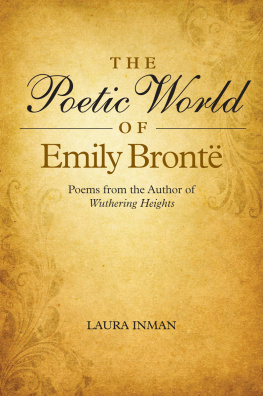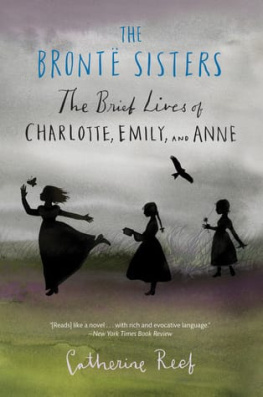Emily Bront is known as a novelist, but she was first and equally a poet. Before during and after writing Wuthering Heights, she wrote poetry. Indeed, she wrote virtually nothing else for us to read no other work of fiction or correspondence. Her poems, however, fill this void. They are varied, lyrical, intriguing, and innovative, yet they are not well known. The Poetic World of Emily Bront brings an unjustifiably marginalized poet out of the shadows and presents her poetry in a way that enables readers, even those who shy away from poetry, to appreciate her work.
Unlike any other collection of Bronts poetry, this volume arranges selected poems by thematic topic: nature, mutability, love, death, captivity and freedom, hope and despair, imagination, and spirituality. It provides literary and biographical information on each topic and interpretations, explanations, and insights into each poem. Fans of Wuthering Heights wanting more from Emily Bront will discover that her poetry is as memorable and powerful as her novel. This book is for all who appreciate poetry, especially from the golden age of 19th century verse. The exploration of Emily Bronts poetic world allows a greater and different understanding of Wuthering Heights and insights into Bronts fascinating mind.
Laura Inman is an independent scholar who has long been fascinated by Emily Bront and has written about Wuthering Heights and Bronts poetry in Bront Studies and Victorians: Journal of Culture and Literature. She is a freelance writer, whose essays and fiction appear in online magazines and blogs, including her own blog, thelivingphilospher.com. Formerly she practiced law, holding a J.D. degree from The University of Texas Law School. She lives in Rye, New York
To my inspiration and teacher,
Professor Billie Jo Inman, Ph.D. in English
The University of Texas 1962
Professor Emerita, The University of Arizona 1963 to1994
Copyright Laura Inman, 2014.
The right of Laura Inman to be identified as author of this work has been asserted in accordance with the Copyright, Designs and Patents Act 1988.
Published in the Sussex Academic e-Library, 2014.
SUSSEX ACADEMIC PRESS
PO Box 139
Eastbourne BN24 9BP, UK
and simultaneously in the United States of America and Canada
All rights reserved. Except for the quotation of short passages for the purposes of criticism and review, no part of this publication may be reproduced, stored in a retrieval system or transmitted in any form or by any means, electronic, mechanical, photocopying, recording or otherwise, without the prior permission of the publisher.
British Library Cataloguing in Publication Data
A CIP catalogue record for this book is available from the British Library.
Library of Congress Cataloging-in-Publication Data
Bront, Charlotte, 18161855.
[Poems. Selections]
The Poetic World of Emily Bront : Poems From the Author of Wuthering Heights / [edited by] Laura Inman.
pages cm
Includes bibliographical references and index.
ISBN 978-1-84519-645-5 (pb : alk. paper)
ISBN 978-1-78284-145-6 (e-pub)
ISBN 978-1-78284-146-3 (e-mobi)
ISBN 978-1-78284-147-0 (e-pdf)
I. Inman, Laura. II. Title.
PR4166.I56 2014
821.8dc23
2014005775
This e-book text has been prepared for electronic viewing. Some features, including tables and figures, might not display as in the print version, due to electronic conversion limitations and/or copyright strictures.
Contents
CHAPTER ONE
Emily Bront, the Poet and the Person
CHAPTER TWO
Nature
CHAPTER THREE
Mutability
CHAPTER FOUR
Love
CHAPTER FIVE
Death
CHAPTER SIX
Captivity and Freedom
CHAPTER SEVEN
Hope and Despair
CHAPTER EIGHT
Imagination
CHAPTER NINE
Spirituality
Introduction
Emily Bront is best known, perhaps solely known, as a novelist, the author of one of the all-time great works, Wuthering Heights. Readers for generations have paused at Lockwoods final words at the graves of Catherine, Edgar, and Heathcliff, with the wistful feeling that accompanies the end, eager to read something else that Emily Bront wrote. At that point, one might discover that she was a poet because there is almost nothing else by her to read except her poetry, no other works of fiction or letters. Luckily, her poems fill the void.
After discovering that Bront was a poet, one can approach her poetry, in the typical way, by reading a few poems at random. Although she is undeservedly marginalized as a poet, there are editions of her poems available. The definitive collection of Bronts poems is The Complete Poems of Emily Jane Bront, by C.W. Hatfield. It serves as a valuable companion for scholars, as all of her poems, even incomplete ones and fragments, are presented in chronological order, without the editing by Charlotte Bront and others that occurred after Bronts death. However, perusing single poems will not acquaint the reader with Bronts poetic work and her life as this book intends to do. First, the poems might pose some difficulties for the uninitiated. Mostly lacking in titles and at times arcane and archaic in diction, her poetry becomes more accessible when read with the explanations and interpretations paired with each poem in this book. Also, having a context for a poem aids in ones understanding of it. Here, selections from her poetic work are arranged according to thematic topics: nature; mutability; love; death; captivity and freedom; hope and despair; imagination; and spirituality. For each topic, I have given biographical, historical, and literary context, including connections to Wuthering Heights. The topical arrangement compensates for the lack of a title and the contextual discussion primes the reader to grasp and appreciate the meaning of the poems in that chapter. Regarding the biographical context in particular, not only does a biographical context for a poem help clarify its meaning, the reverse holds true: one can gain otherwise unknowable information about Bronts personality and views from her poems. Because biography figures so importantly in this dual role, I have started this book with a general outline of Bronts life and have added to the facts my deductions about certain personality traits and beliefs relevant to a better understanding of her poetry. Also, throughout the book, I make connections among her life, her poetry, and her novel as well. Indeed, all three the identity of the poet, the poems, and Wuthering Heights coalesce into Bronts poetic world. Given that the whole is a sum of the sequential chapters, this book is best read by turning the pages in order. Although the usual edition of poetry does not demand reading from beginning to end, it is a distinguishing feature of this book of poetry that it should be read initially in that manner because there is a thematic progression to the presentation of the poems: ideas in the poems connect and often build upon preceding notions, as do my discussions about the poems.
There are two points of clarification that pertain to the presentation of the poems. First, as mentioned above, most of Bronts poems do not have titles, so I have identified them by their first lines, even those few that do have a title. The lack of titles is unusual, but not unprecedented; for example, Shakespeares sonnets do not have titles. Second, any one-time curious word-usage or archaism is explained when it appears in a poem. However, the following frequently appear. Brow can be read to mean forehead, but in other instances suggests the entire face. The predilection for that word seems to be its ease for rhyming. The word below appears many times, such as in the lines, We part below to meet on high. It is a shorthand way of saying on earth as opposed to in heaven. The word beneath is at times used in that same way. Also designating human existence on earth is the word clay, as in the lines, Alas! the countless links are strong / that bind us to our clay. Bront typically uses the archaic thee, thou, thy, and thine, which she would not have used in speaking. The use of those pronouns for the modern you and yours was poetic convention and also would have facilitated rhyming.
Next page












